by John Semlak | Nov 6, 2017 | #NYCSports, #ONTHISDAY, #SportsHistory
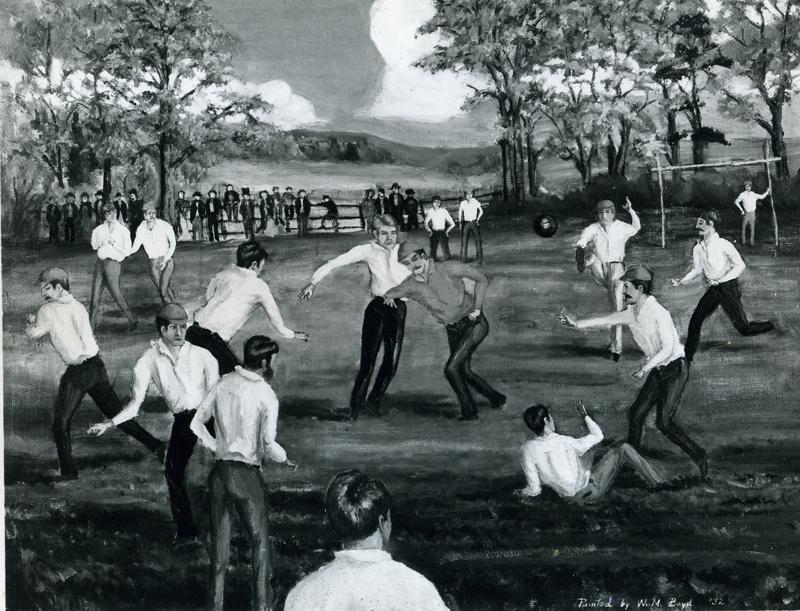 Painting of the match by Rutgers graduate William Boyd
Painting of the match by Rutgers graduate William Boyd
On November 6th 1869 at College Field on the campus of Rutgers University in New Jersey, two teams from Rutgers and the College of New Jersey (today Princeton) met each other to play a match under the London Football Association rules. The teams were 25 players each and they wore no uniforms. The rules resembled soccer more than college football–the players were not allowed to carry or throw the ball. Teams scored a goal (also called a ‘run’ in newspaper reports) by kicking the ball into a goal. Rutgers won 6-4. It was the first of two games Rutgers and Princeton played in 1869 in the first ever college football season.
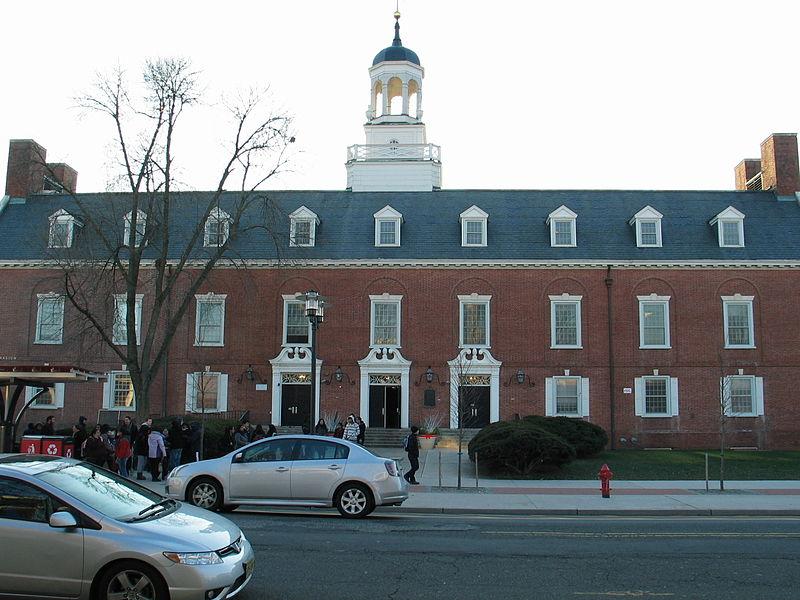 College Avenue Gymnasium, site of the match
College Avenue Gymnasium, site of the match
In 1870 Rutgers would play Columbia College in another game under similar rules. However, in 1874 Canada’s McGill University and Harvard played each other in a game under rules of the ‘Boston game,’ which were derived from the Rugby Football Union in England and allowed carrying the ball. From there, the college football would evolve into the rules of the gridiron played today. Nevertheless, the Rutgers-Princeton match in 1869 is considered the ‘Birth of College Football’.
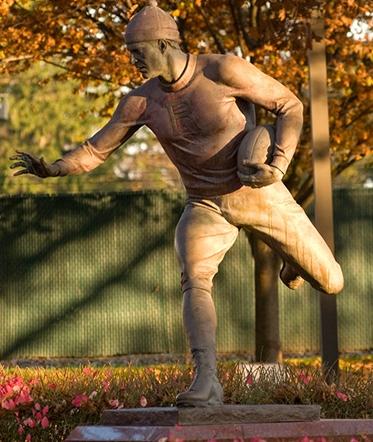 The First Football Game Monument at High Point Solutions Stadium (photo from Rutgers University website)
The First Football Game Monument at High Point Solutions Stadium (photo from Rutgers University website)
The site of the match is now Rutgers’ College Avenue Gymnasium, which now has a plaque depicting the Rutgers players in the match. A statue entitled The First Football Game Monument stands outside Rutgers’ current home High Point Solutions Stadium, though it inaccurately depicts a player carrying the ball.
by John Semlak | Oct 14, 2017 | #NYCSports
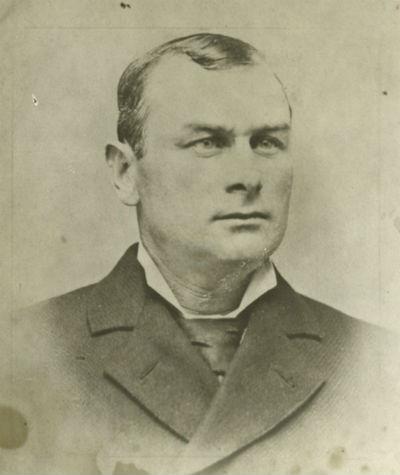 Joe Start with the New York Mutuals
Joe Start with the New York Mutuals
On October 14th 1842, Joseph ‘Joe’ Start was born in New York City. He would become a baseball star and one of the greatest 1st baseman of the era. Start played with the Brooklyn Atlantics from 1862-1870. He won four National Association championships and in 1870 he played in the Atlantics’ showdown with the undefeated Cincinnati Red Stockings in which he starred.
He started his career with the short lived Brooklyn Enterprise club, and then moved to the Atlantics in 1862. He became known for fast baserunning, good fielding and modest power with the bat. He is credited by some with being the first to away from the bag at first base, now the standard positioning. After the first professional league was formed in 1871, Start switched to the New York Mutuals, where he played for six years. He played one season for the Chicago White Stockings (now the Cubs) before playing for the Providence Grays for six more seasons. He finished his career at age 43, and earned the nickname ‘Old Reliable’. He’s buried in Riverside Cemetery in Rhode Island.
In the summer of 1870 the Cincinnati Red Stockings arrived with an 84-match winning streak. They met the Atlantics in a highly-anticipated game at the Capitoline Grounds in today’s Bedford-Stuyvesant in front of 20,000 spectators. Start hit a sacrifice fly in the 8th inning to tie the match at 5-5. In the bottom of the 11th down 7-5, Start hit a triple with a man on, setting himself up as the tying run at 3rd. He was then knocked in by captain Bob Ferguson, who would ultimately score the winning run for a final score of 8-7, ending Cincinnati’s legendary streak. Start’s triple was arguably the play of the game.
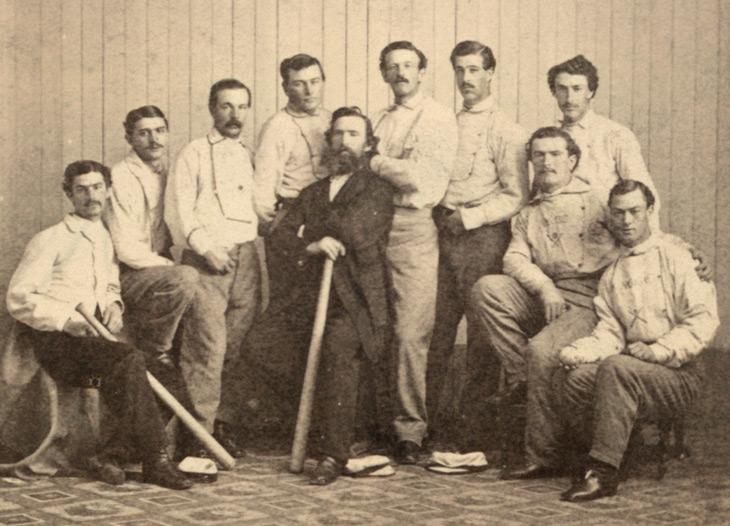 The Brooklyn Atlantics in 1865. Joe Start is standing 4th from the left.
The Brooklyn Atlantics in 1865. Joe Start is standing 4th from the left.
by John Semlak | Oct 5, 2017 | #NYCSports, #ONTHISDAY
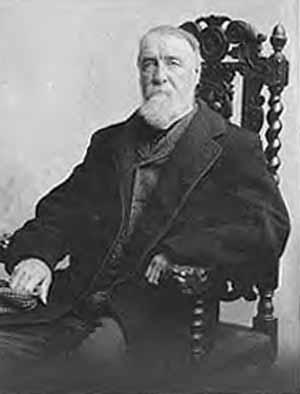 Henry Chadwick
Henry Chadwick
English journalist and sports-writer Henry Chadwick was born on October 5th, 1824 in Exeter England. He emigrated to the US at the age of 12 with his family and settled in Brooklyn. He found work as a journalist covering sports and was especially fond of cricket. He first saw a baseball game while covering cricket for the New York Times in 1856 and developed a life-long passion for the game. Working for various papers, he developed the box score, the terms ERA and Batting Average, and other scorekeeping tools still used today. When he died in 1908 he was credited as the ‘father of baseball’, though he is one of several persons who can credibly claim this title. His grave at Green-Wood Cemetery in Brooklyn is a must-see for baseball lovers.
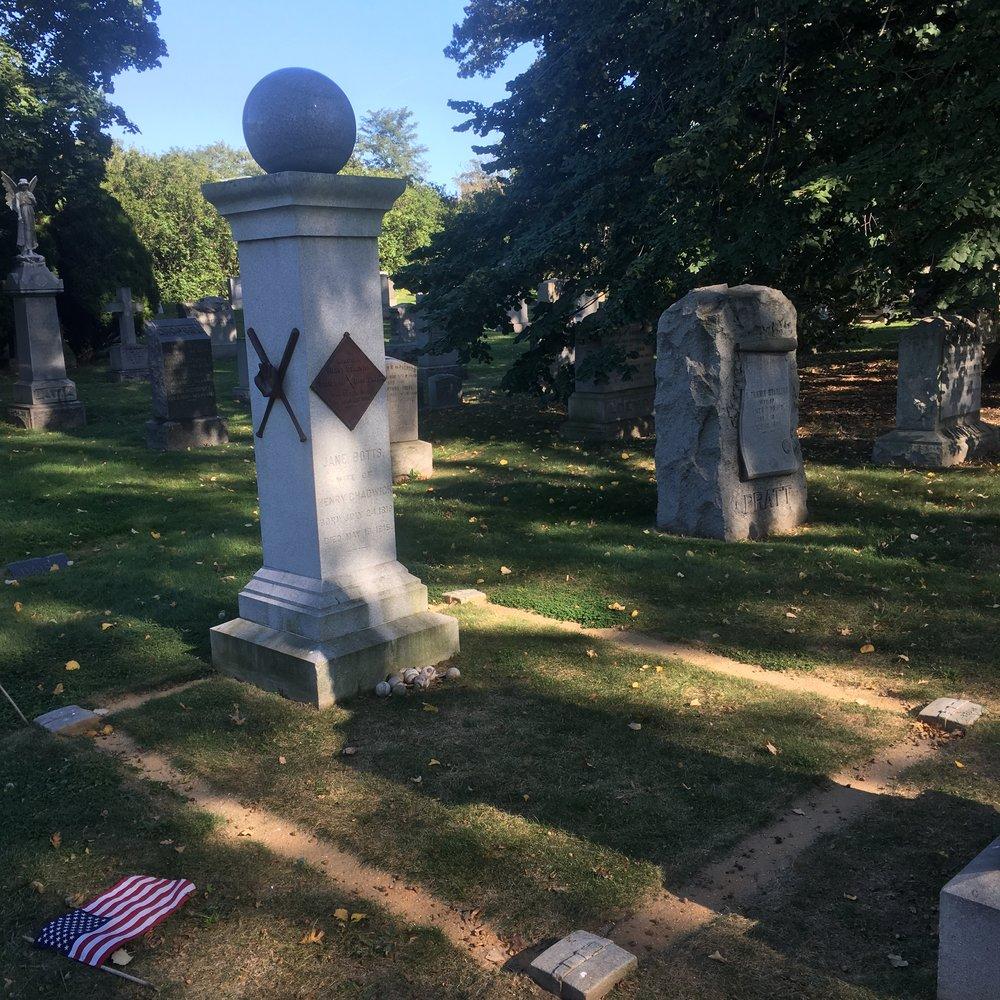 Chadwick’s grave in Green-Wood Cemetery, with a baseball carved on the headstone.
Chadwick’s grave in Green-Wood Cemetery, with a baseball carved on the headstone.
by John Semlak | Oct 4, 2017 | #NYCSports, #ONTHISDAY
 England playing the United States in Hoboken
England playing the United States in Hoboken 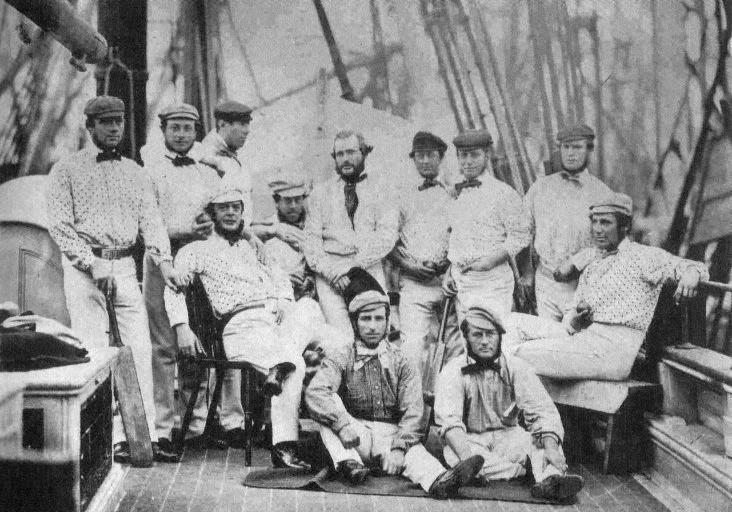 The English team on a ship in Liverpool on their way across the Atlantic
The English team on a ship in Liverpool on their way across the Atlantic
On October 3rd, 1859, a team of 11 English cricketers and a team of 22 cricketers from New York began a 3-day cricket match at the Elysian Fields in Hoboken, New Jersey. The English team was on a tour of North America and played five matches in Canada and the US. It was the first ever overseas tour of the English cricket team, and 18 years before the first England-Australia test match in Melbourne. The English won all five matches, including the one in Hoboken.
The match in Hoboken was played at the home ground of the St. George’s Cricket Club, the most dominant cricket club in the New York area. Founded in 1838, they first started playing in Manhattan at various grounds before moving to Hoboken, using a site very near the field used by the Knickerbocker Baseball Club at the time. The team of 22 players (the American team was allowed to have two sets of the 11 players normally required to play cricket as an advantage) drawn from the St George club and other cricket clubs in the area, such as the New York Cricket Club or the Union Star club in Brooklyn. Players for the US team, many who were of English birth, included Sam Wright, his son and future baseball player and hall-of-famer Harry Wright, and glass-maker Henry E. Sharp. The English won the match easily, scoring 156 runs to the US’s 92. The English only had to bat for one innings to score more runs than the Americans did in two innings, equivalent to scoring more points in a single half of a basketball game than their opponent scored the whole game.
The poor result for US cricket during tour did not limit excitement around the matches. They were well attended and covered in the press, and the attention increased the interest in cricket which was then a strong rival to baseball in popularity in the US. A second English tour was planned. However, the Civil War put an end to this. After the war, baseball became the dominant sport in the US and cricket never recovered.
by John Semlak | Aug 22, 2017 | #NYCSports
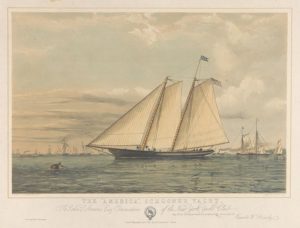 The schooner America, designed by George Steers
The schooner America, designed by George Steers  A replica of the original 1844 clubhouse of the New York Yacht Club at its original location in Hoboken, New Jersey
A replica of the original 1844 clubhouse of the New York Yacht Club at its original location in Hoboken, New Jersey
On August 22 1851 the schooner America defeated 14 British yachts in a race around the Isle of Wight. The race became the inaugural edition of the America’s Cup, the oldest sporting competition in the world. It was also one of the greatest upsets of sports history. Great Britain was considered the master of all things maritime with centuries of tradition in sailing, while the United States was still an upstart nation. The New York Yacht Club (NYYC), the challenger, was only seven years old. The NYYC would continue to hold the America’s Cup for 132 years. The Cup bears the name of the winning yacht of the first race.
The race was organized by the Royal Yacht Squadron (RYS), founded in 1815. The RYS invited the New York Yacht Club to challenge British vessels in conjunction with the Great Exhibition of 1851 (also known as the Crystal Palace Exhibition). The challenge was accepted by the NYYC Commodore and founding member John Cox Stevens. A trophy was made by London silversmith Robert Garrard. It was initially called the ‘£100 Cup’, and was a bottomless ewer than has come to be called the “Auld Mug”.
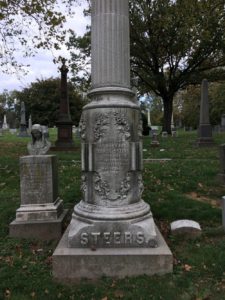 George Steers’ grave in Green-Wood Cemetery in Brooklyn
George Steers’ grave in Green-Wood Cemetery in Brooklyn
The yacht America was designed for the NYYC by George Steers, along with his brother James. It was built in Steers’ shipyard in Greenpoint, today a neighborhood in Brooklyn. Steers was asked by NYYC member George Schuyler to build a yacht of immense speed suitable for racing. It was named the America. Though built for speed it also contained many amenities including a washroom with a bathtub, at a time when most homes lacked such facilities.
The NYYC chose Richard ‘Dick’ Brown as a pilot, an experienced Sandy Hook pilot, a group of pilots specializing in guiding ships through the dangerous waters surrounding New York Harbor. He chose as his first mate a young pilot named Nelson Comstock.
The America sailed across the Atlantic to England with tremendous expectations on it shoulders. This was a ship that was expected to compete against the very best British ships. Even many Americans with doubtful that an American ship could outclass the best ships in the world. The New York Tribune publisher Horace Greeley, who was then in Europe, urged John Stevens to not race against the British, saying they would be beaten; Greeley also told them if they lost they should not return to the US. The arrival of the America did generate considerable interest in the British press and among local yachtsmen, which built up the excitement for the upcoming race.
The race started at Cowes Castle on the Isle of Wight where Royal Yacht Squadron was headquartered. 15 yachts started the race, including the America. The route was the Queen’s Course, a 53-nautical mile course (98 km) around the island. Observers included Queen Victoria and Prince Albert, who watched aboard the royal yachts. The race was started by gunfire from the batteries at 10:00 am on August 22nd.
 The America’s Cup, made by London Silversmith Robert Garrard
The America’s Cup, made by London Silversmith Robert Garrard
Piloted with precision and concentration by Brown, the America passed several yachts quickly and after about 30 minutes took the lead, which it would maintain throughout the race. Brown increased its lead by successfully maneuvering between the island and the Nabs Point lighthouse, a possible shortcut in the race. Soon the lead seemed so insurmountable that Victoria and Albert retired from viewing. But the small cutter Aurora did mount a late challenge. Rounding St Catherine’s point on the south of the Isle, the Aurora fell into a beam’s reach, a favorable point of sail. Behind a strong wind, the Aurora gained fast, largely unbeknownst to the crowd at the finish line that believed the America was winning easily. However, the America held off the challenger and crossed the finish line at 10 hours and 34 minutes, 8 minutes ahead of the Aurora. When informed that America had won, Queen Victoria asked who finished second. The response was, perhaps apocryphally, “Your Majesty, there is no second.”
 The America crosses the finish line first. When Queen asked who finished second; the answer was, “Your Majesty, there is no second.”
The America crosses the finish line first. When Queen asked who finished second; the answer was, “Your Majesty, there is no second.”
The result was a shock for the sailing world and especially for British yachtsmen. But the British press and public showed tremendous sportsmanship in defeat. The crowd cheered America‘s victory. Queen Victoria personally congratulated John Cox Stevens. In later months the British press analyzed the race and wrote articles on how to improve yacht design to match Steers’ superior vessel. Back home, Americans were much less gracious in victory. News arrived by steamship in September. Newspapers declared the victory proof of US superiority over its former colonial master. The New York Herald declared, “We have beaten them on land and at sea.”
 Exterior of the current clubhouse of the New York Yacht Club on 44th Street in Midtown Manhattan.
Exterior of the current clubhouse of the New York Yacht Club on 44th Street in Midtown Manhattan.
The New York Yacht Club was awarded the silver ewer as a trophy for the award. It was renamed the “America’s Cup”, after the winning ship. It was meant to be defended against legitimate challengers. The first such challenge happened in 1870, hosted by the NYYC in the US. Many later challenges followed, most held at the NYYC’s headquarters in Newport, RI. The trophy was only lost 132 years and 26 challenges later in 1983 to the Royal Perth Yacht Club and the ship Australia II. The NYYC has never regained the title, though other American clubs have.
by John Semlak | Jun 14, 2017 | #NYCSports
On June 14th 1870 two baseball teams met in Brooklyn in one of the most highly anticipated matches of the 19th century. One team was a reigning and 8-time champion. The other was on an 81 game winning streak. By the end of the match, there had been 6 lead changes and plenty of controversy. It ended with a rally in extra innings to end one of the longest streaks in baseball history. The match took place at the Capitoline Grounds in Brooklyn between the Brooklyn Atlantics and the Cincinnati Red Stockings.
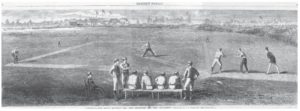 The Brooklyn Atlantics playing the Cincinnati Red Stockings at the Capitoline Grounds in Brooklyn on June 14th, 1870
The Brooklyn Atlantics playing the Cincinnati Red Stockings at the Capitoline Grounds in Brooklyn on June 14th, 1870
In 1870 baseball clubs were mostly amateur at least officially. Rumors had abounded for over a decade that clubs paid some players, but they claimed to be fully amateur. The sport of baseball definitely started that way. The first clubs such as the New York Knickerbockers or the Brooklyn Putnams started as groups of bookkeepers, firefighters, insurance salesmen, and other professionals playing in their spare time. Over the years the game became more organized and more commercial. Teams started to charge admission to matches. A league was formed: The National Association of Base Ball Players (NABBP). Champions were declared. The stakes of winning matches grew.
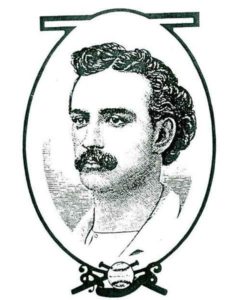 Lip Pike, a 2nd baseman for the Atlantics and one of first Jewish baseball stars.
Lip Pike, a 2nd baseman for the Atlantics and one of first Jewish baseball stars.
The game of baseball as we know it started in the New York area. While it spread to other cities, the strongest teams in early years in what is now New York. Successful teams before the founding of the first professional league in 1871 included the New York Mutual, the Union of Morrisania (in the Bronx) and the Brooklyn Excelsior. But during the 1860s the most dominant club was the Brooklyn Atantics. They won 8 NABBP championships. They featured stars like outfielder Jack Chapman, known as the “Death to Flying Things, catcher Bob Ferguson, the first known switch-hitter, LIp Pike, a star hitter and second baseman, and slugger Joe Start. Lip Pike was one of the first known Jewish baseball players. Starting in 1862, their home ground was the Capitoline Grounds in today’s Bedford-Stuyvesant.
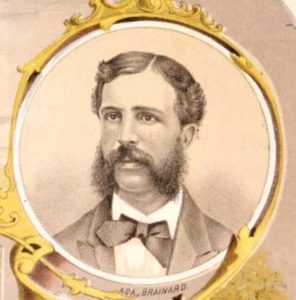 Pitcher Asa Brainard, the origin of the term ‘ace’.
Pitcher Asa Brainard, the origin of the term ‘ace’.
The Cincinnati Red Stockings were a much newer club. Formed in 1866, they were soon joined by Harry Wright, a cricket and baseball player who moved from New York to join the Union Cricket Club in Cincinnati, but quickly became the player-manager of the Red Stockings. He began bring in stars from the East, mostly New York, including his own brother George Wright at short stop and star pitcher Asa Brainard from the Brooklyn Excelsior (the term ‘Ace’ meaning a star pitcher is derived from Brainard). By 1869 each player was paid a salary, making it the first openly professional team. In 1869 the Red Stockings won all 57 of their games. The next year they continued their streak. In the summer of 1870 they journeyed East to play the toughest teams. On June 13th they defeated the New York Mutuals to bring their streak to 81 games. Their next match was with the mighty Atlantics.
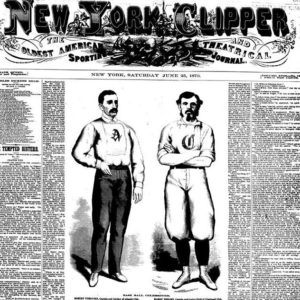 An illustration of the two captains of the match in the New York Clipper sporting newspaper: Brooklyn’s Robert Ferguson and Cincinnati’s Harry Wright.
An illustration of the two captains of the match in the New York Clipper sporting newspaper: Brooklyn’s Robert Ferguson and Cincinnati’s Harry Wright.
Papers predicted Cincinnati would win. They had beaten the Atlantics the previous year 32-10. But this Atlantics team didn’t fear the Western upstarts. They were a squad of grizzled veterans who had won multiple championships. In fact they had claimed the 1869 National Association title despite Cincinnati’s perfect season due to the rather arcane rules of the time (teams didn’t have a uniform schedule and there was no league table). This background created intense anticipation for the match. The crowed was estimated at about 20,000, one of the largest ever crowds for a sporting event. The New York World reported:
“Little urchins shouted, ‘score cards, names and positions of both nines,’ all the way from Fulton Ferry to Bedford, and all Brooklyn seemed awake to the event of the day. Stores were deserted, boys who could not obtain permission to leave school played hooky, and hundreds who could or would not produce the necessary fifty-cent stamp for admission looked on through cracks in the fence, or even climbed boldly to the top, while others were perched in the topmost limbs of the trees, or on the roofs of surrounding houses.”
Cincinnati as expected opened the scoring with three runs early. But Brooklyn got back into it and took the lead 4-3 in the 6th. Both teams added runs to bring the score to 5-5 after 9 innings. In those days extra innings were not mandatory. Cincinnati could have opted to preserve their unbeaten streak by accepting a tie. But Cincinnati manager Harry Wright asked to continue. The New York Tribune reported that while the score was small, the “excitement was unbearable”.
 Atlantic Joe Start’s 11th inning triple set up the tying run and was one of the plays of the game.
Atlantic Joe Start’s 11th inning triple set up the tying run and was one of the plays of the game.
The 10th inning went scoreless. However, the Atlantics had men on base but their effort was foiled when Cincinnati shortstop George Wright let a pop fly drop and converted an easy double play (there was no infield fly rule then). In the 11th inning the Red Stockings appeared to have won the match with two runs to make the score 7-5. But once again the Atlantics rallied. With a runner on, Brooklyn’s Joe Start smashed a ball over right fielder Cal McVey’s head for a triple, which was aided by a spectator jumping on McVey’s back (just part of the home field advantage in those days). The tying run was then driven in by Bob Ferguson. Ferguson then scored the final and winning run when George Wright botched a double play that could have ended the inning. Brooklyn was victorious winning 8-7.
 Headline in the Brooklyn Daily Eagle
Headline in the Brooklyn Daily Eagle
The New York papers lavished praise on the triumphant Atlantics and the game itself. The Brooklyn Daily Eagle claimed that the ‘local nine defeated the picked nine.’ The New York Times called it the ‘most exciting game on record.” The New York Sun claimed the Atlantics’ fans celebrated like ‘escaped lunatics.” The Times judged the partisanship of the crowd harshly, calling it “the most discreditable gathering we have seen at the Capitoline Grounds in years.” But the game was immediate recognized as one of the greatest ever played, and remains a significant milestone in the history of the game.
 The site of the Capitoline Grounds today. The Grounds were bound by Nostrand, Halsey, Marcy, and Putnam Streets.
The site of the Capitoline Grounds today. The Grounds were bound by Nostrand, Halsey, Marcy, and Putnam Streets.
Both clubs would fold in the following years. With no tenant the Capitoline Grounds became run down and was demolished in 1880 and the land was sold for housing. There’s little evidence of the ground today. In New York, perhaps the best places to visit related to this historic match are the city’s cemeteries, where many of the players are buried. The most significant one is Green-Wood Cemetery in Brooklyn, the resting place of three players on that day: Asa Brainard, Jack Chapman, and Charlie Smith. Also buried at Green-Wood is Alexander Hamilton Weed, a co-owner of the Capitoline Grounds. Atlantics captain Robert Ferguson is buried at Cypress Hills Cemetery. Lip Pike is buried at Salem Fields Cemetery.
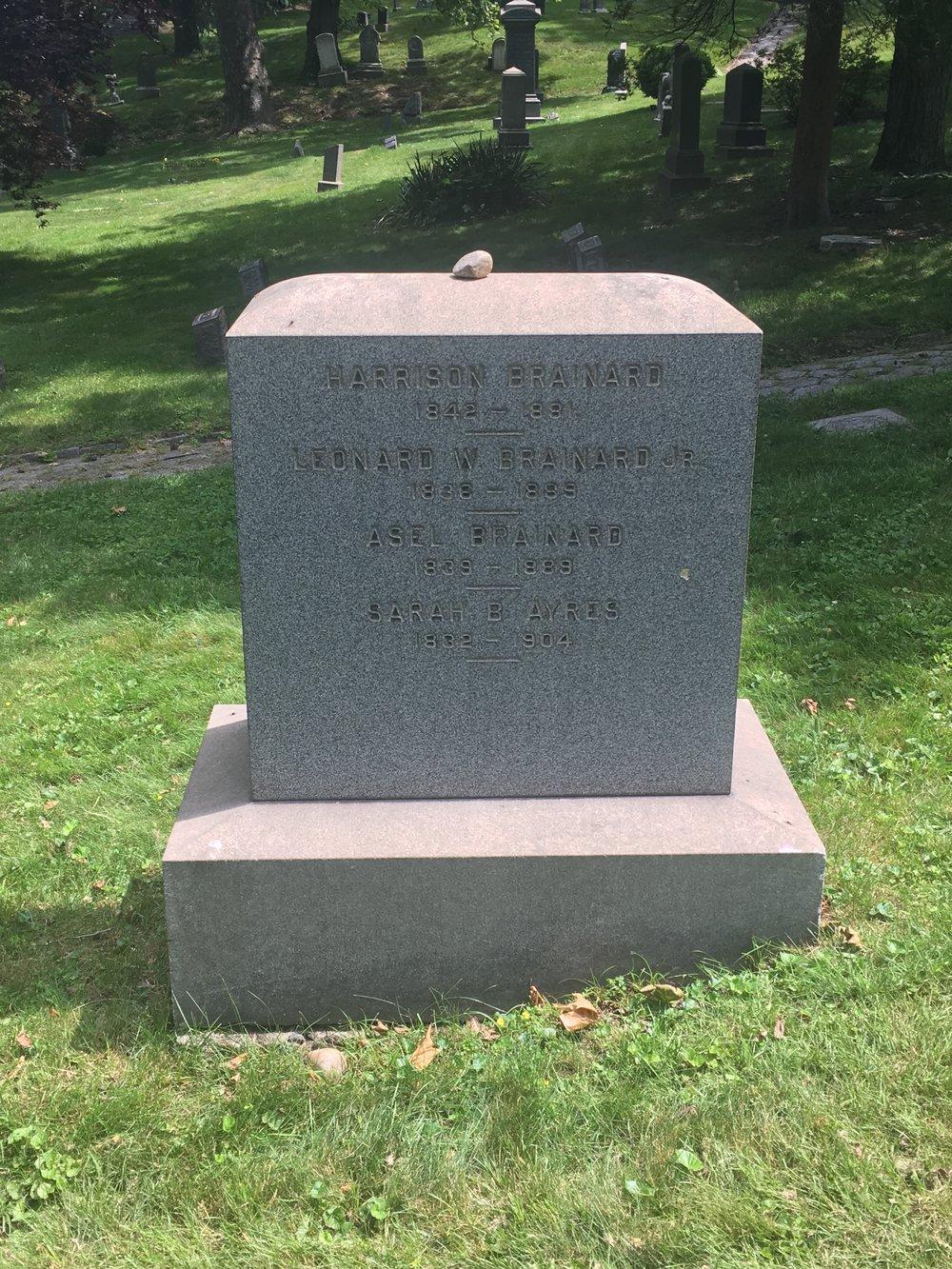
Grave of Asa Brainard at Green-Wood Cemetery in Brooklyn
 Painting of the match by Rutgers graduate William Boyd
Painting of the match by Rutgers graduate William Boyd College Avenue Gymnasium, site of the match
College Avenue Gymnasium, site of the match The First Football Game Monument at High Point Solutions Stadium (photo from Rutgers University website)
The First Football Game Monument at High Point Solutions Stadium (photo from Rutgers University website) Joe Start with the New York Mutuals
Joe Start with the New York Mutuals The Brooklyn Atlantics in 1865. Joe Start is standing 4th from the left.
The Brooklyn Atlantics in 1865. Joe Start is standing 4th from the left. Henry Chadwick
Henry Chadwick Chadwick’s grave in Green-Wood Cemetery, with a baseball carved on the headstone.
Chadwick’s grave in Green-Wood Cemetery, with a baseball carved on the headstone. England playing the United States in Hoboken
England playing the United States in Hoboken  The English team on a ship in Liverpool on their way across the Atlantic
The English team on a ship in Liverpool on their way across the Atlantic The schooner America, designed by George Steers
The schooner America, designed by George Steers  A replica of the original 1844 clubhouse of the New York Yacht Club at its original location in Hoboken, New Jersey
A replica of the original 1844 clubhouse of the New York Yacht Club at its original location in Hoboken, New Jersey George Steers’ grave in Green-Wood Cemetery in Brooklyn
George Steers’ grave in Green-Wood Cemetery in Brooklyn The America’s Cup, made by London Silversmith Robert Garrard
The America’s Cup, made by London Silversmith Robert Garrard The America crosses the finish line first. When Queen asked who finished second; the answer was, “Your Majesty, there is no second.”
The America crosses the finish line first. When Queen asked who finished second; the answer was, “Your Majesty, there is no second.” Exterior of the current clubhouse of the New York Yacht Club on 44th Street in Midtown Manhattan.
Exterior of the current clubhouse of the New York Yacht Club on 44th Street in Midtown Manhattan. The Brooklyn Atlantics playing the Cincinnati Red Stockings at the Capitoline Grounds in Brooklyn on June 14th, 1870
The Brooklyn Atlantics playing the Cincinnati Red Stockings at the Capitoline Grounds in Brooklyn on June 14th, 1870 Lip Pike, a 2nd baseman for the Atlantics and one of first Jewish baseball stars.
Lip Pike, a 2nd baseman for the Atlantics and one of first Jewish baseball stars. Pitcher Asa Brainard, the origin of the term ‘ace’.
Pitcher Asa Brainard, the origin of the term ‘ace’. An illustration of the two captains of the match in the New York Clipper sporting newspaper: Brooklyn’s Robert Ferguson and Cincinnati’s Harry Wright.
An illustration of the two captains of the match in the New York Clipper sporting newspaper: Brooklyn’s Robert Ferguson and Cincinnati’s Harry Wright. Atlantic Joe Start’s 11th inning triple set up the tying run and was one of the plays of the game.
Atlantic Joe Start’s 11th inning triple set up the tying run and was one of the plays of the game. Headline in the Brooklyn Daily Eagle
Headline in the Brooklyn Daily Eagle The site of the Capitoline Grounds today. The Grounds were bound by Nostrand, Halsey, Marcy, and Putnam Streets.
The site of the Capitoline Grounds today. The Grounds were bound by Nostrand, Halsey, Marcy, and Putnam Streets.